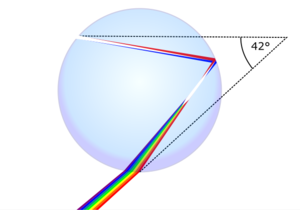Rainbow
Contents
hideExplanation
Rainbow is a phenomenon observed mostly in the Earth's atmosphere when the visible light from the Sun reflects and refracts inside the raindrops that are opposite to the Sun. The phenomenon can be observed as an arc if an observer looks at these raindrops from an angle of 42°. The formation of the arc is the result of dispersion of the visible light into its individual components — Red, Orange, Yellow, Green, Blue, Indigo, and Violet (ROY G BIV).
Here is how it works! When the visible light enters a rain droplet, some of it refracts through the drop, which means that the individual components of the light slows down when entering the water medium and thereby bend at different angles due to dispersion. Some of this refracted light then reflects from the inner walls of the droplet like a mirror at an angle. When this light refracts again through the opposite wall of the droplet, the individual components of the light that are at different wavelengths leave the water medium and enter the air medium at different angles as a spectrum. When viewed from a 42° angle, we see the individual components of each raindrop. The result is a beautiful arc of all the different colours spanned out across the droplets in the sky that are exactly at 42°. When the observer is looking at the rainbow from a certain height, say from an airplane, they would be observing a complete circle of a rainbow.
Frequently Asked Questions
What causes a double rainbow?
Double rainbows are caused when the light inside the rain droplets reflect twice, either up or down. The first reflection causes the primary rainbow whereas the second reflection causes another rainbow at an angle of 52°. The second rainbow will also have all its colours inverted if the reflection is upwards due to the angle of refraction of the second reflected light. It is possible for the light to be reflected more than twice, but the intensity of tertiary rainbows would be so low, and hence they are rare to spot.
What is a supernumerary rainbow?
Supernumerary rainbows occur when the reflected light waves interfere with one another. When they interfere, the bands causes different hues of light because of the combined effect of constructive and destructive interference. This leads to the formation of bands of other hues inside the primary rainbow, known as the supernumerary rainbow.
Why does the sky appear dark above a rainbow?
When the Sun light enters the raindrops, they enter the medium everywhere. The reason we see the rainbow is that the light that refracts back to our eyes have their maximum intensity between 40° to 42°. The rest of refracted light falls below the violet end, where they interfere with one another to form white light. This makes the region inside the rainbow to appear brighter than the region outside the rainbow.

